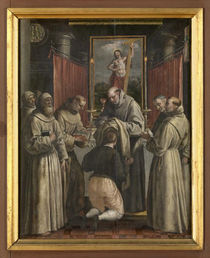The Catholic Defender: Saint Joseph Cafasso "Priest of the Gallows"
- Donald Hartley

- Jun 17
- 3 min read
Updated: Jun 18
Deepertruth with special permission and aid with Franiciscan Media, a great team for the Lord
\

Even as a young man, Joseph loved to attend Mass and was known for his humility and fervor in prayer. After his ordination, he was assigned to a seminary in Turin.
It was often said that no one who knew Cafasso as a child ever could recall him having sinned, seeing him as a model individual.
He is known as the "Priest of the Gallows" due to his extensive work with those prisoners who were condemned to death.
There he worked especially against the spirit of Jansenism—an excessive preoccupation with sin and damnation. He used the works of Saint Francis de Sales and Saint Alphonsus Liguori to moderate the rigorism popular at the seminary.
In his childhood Cafasso felt called to become a priest and so commenced his ecclesial studies in Turin and Chieri in order to achieve his dream.
Joseph recommended membership in the Secular Franciscan Order to priests. He urged devotion to the Blessed Sacrament and encouraged daily Communion. In addition to his teaching duties, Joseph was an excellent preacher, confessor, and retreat master. Noted for his work with condemned prisoners, he helped many of them die at peace with God.
In addition to his teaching duties, Joseph was an excellent preacher, confessor, and retreat master. Noted for his work with condemned prisoners, he helped many of them die at peace with God.

He was a sought after confessor and spiritual adviser, and ministered to prisoners – working to improve their terrible conditions. He met Don Bosco in 1827 and the two of them became great friends.
Joseph urged one of his former pupils—Saint John Bosco—to establish the Salesians congregation to work with the youth of Turin. Joseph Cafasso died in 1860, and was canonized in 1947. His liturgical feast is celebrated on June 23.
He was famous for his ministry with prisoners, and is patron saint of those in jail and those who care for them. The prisons of his day herded the condemned together under horrible conditions, and he visited men, giving them dignity and inspiring hope.
The cause for his canonization commenced after his death that led to his beatification in mid-1925 and his canonization two decades later on 22 June 1947; he is a patron for Italian prisoners and prisoners amongst other things
The process for canonization opened in Turin in a local process that would assess his saintliness and evaluate his spiritual writings; the formal introduction to the cause came in an official decree that Pope Pius X signed on 23 May 1906 while the confirmation of his heroic virtue allowed Pope Benedict XV to title Cafasso as Venerable. Pope Pius XI confirmed two miracles attributed to Cafasso's intercession on 1 November 1924 while - in the official decree - labelling Cafasso as "the educator and formation teacher of priests". Pius XI presided over the beatification on 3 May 1925. Pope Pius XII confirmed two more miracles and canonized Cafasso in Saint Peter's Basilica on 22 June 1947.
Pius XII - on 9 April 1948 - declared him to be the patron saint of all Italian prisons and prisoners.
Devotion to the Eucharist gave energy to all Joseph’s other activities. Long prayer before the Blessed Sacrament has been characteristic of many Catholics who have lived out the gospel well: Saint Francis, Bishop Fulton Sheen, Cardinal Joseph Bernardin, and Saint Teresa of Calcutta among them.





















Comments